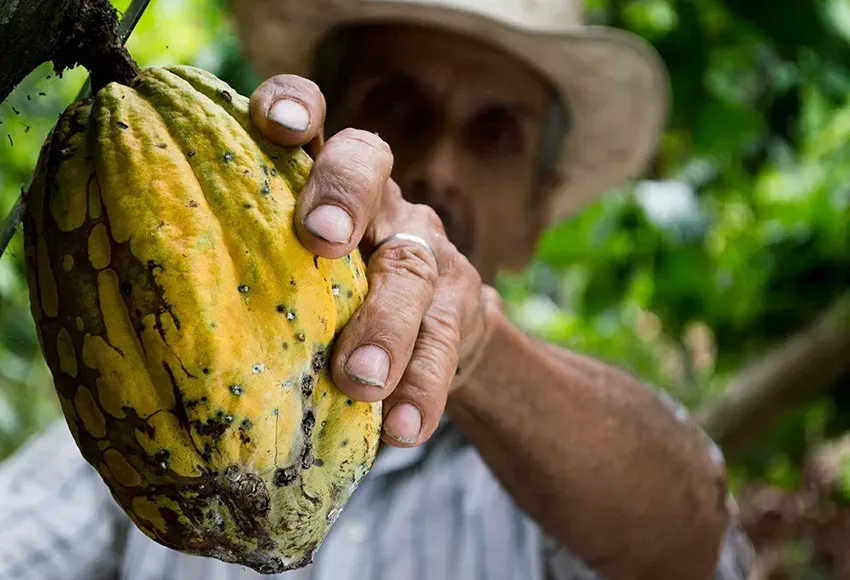"It doesn't make sense to ask an Ivorian what cocoa means to him! It means everything! It's his first source of income! My education was funded by cocoa! Our houses are built with cocoa! The foundation of our roads, our schools, our hospitals is cocoa! Our government runs on cocoa! All our policy focuses on sustaining cocoa!" So said N'Zi Kanga Rémi, the governor of the rural department of Adzopé to The Guardian in February 2019.
When we think of slavery, many of us picture someone bought or sold with the intent of subjecting them to hard, free, or cheap labor. While it may be difficult to envision someone who willingly goes each day to fulfill a task as a slave, in places like Ghana and Côte d'Ivoire, it's a tragic reality.
The $100 billion chocolate industry allows over five million cocoa farmers from these countries to live in a state of poverty that rewards most of their hard work with as little income as $200 a year. These West Africans are responsible for 60–70% of the global cocoa production, which comes to around four million tons. Yet they live below the poverty line, making less than one dollar a day.
The farmers in these top-producing countries have their hard work exploited at the bottom of a complex supply chain that allows buyers, traders, shipping and processing companies, manufacturers, retailers, and consumers to benefit while they have little to no access to clean water, healthcare, sanitation, electricity, or education.
A business with a billion consumers should be able to provide living wages for all members of the supply chain, but instead, the major companies that make the most hoard the profits. This results in children being trafficked to work on West African cocoa farms, typically by their own family, whose farms would not survive without them.
Desperate for a higher income and unable to control the price of the beans they sell, many farmers attempt to grow more cocoa by destroying protected rainforests. Of the 244 protected areas in the Côte d'Ivoire (also known as the Ivory Coast), 200 of them are gone, and 13 of the 23 protected chimpanzee habitats have lost their entire primate populations.
There are marked boundaries that say "protected area," but there is nothing left. Small trees have been chopped down and large, ancient trees burned to provide space and much needed sunlight for cocoa plantations.
The primary issue is the entire economics of the chocolate industry, which thrives on keeping its farmers poor. It's easy to villainize the people responsible for destroying their own rainforest, but if you give a poor farmer the choice between protecting the rainforest or feeding their family, then they don't really have a choice at all.
Being one farmer in a sea of five million, when there are no price or labor regulations, means that the majority of the time, they are forced to take what they can get for the cocoa they have worked so hard to produce.
Sometimes that leaves them being paid nothing at all, such as after the massive price drop in 2015 from too much product and not enough demand. Prices for cocoa beans dropped as much as 40% in 2016 and 2017 and never really recovered – but traders made approximately $4.7 billion in profit from being able to purchase cheaper beans. However, when Côte d'Ivoire and Ghana tried to negotiate a new price for cocoa beans in 2019, $2,600 per ton, the cocoa industry refused.
Exploitation up and down the ladder
The exploitation of these farmers and their children travels up the distribution ladder. Farmers sell their bags of cocoa beans to pisteurs, people able to afford trucks, who load and sell as many bags as they can but are at risk of hijackings that sometimes end in their murders. The co-ops pisteurs sell to clean and repack the beans, and load them on to the boats to send overseas – but they are also subject to the price exporters are willing to pay and aren't paid until a deal is struck.
If the chocolate industry were a pyramid scheme, the farmers would be at the bottom and the traders would be at the top. They provide the least amount of labor in the process of making chocolate but reap the highest profits. The biggest traders – Barry Callebaut, Olam, ECOM, Sucden, and Cargill – sell finished versions of chocolate: liquor, cocoa butter, cocoa powder. It was recently discovered by Mighty Earth and Stand.Earth that these companies sell under different business names to hide the size of their monopolies or keep the value of their trade a secret.
As far back as 2001, these companies signed the Harkin-Engle Protocol, in which they agreed to stop using child labor by 2005. However, they have given themselves endless time extensions, now promising a 70% reduction in child labor by 2025. While some conditions have improved over time, most have gotten worse. NORC (the National Opinion Research Center) at the University of Chicago and funded by the US Department of Labor conducted a study in 2020 that showed that 1.56 million child laborers were working in cocoa-growing areas of Côte d'Ivoire and Ghana during the 2018–19 growing season.
These companies' failure to take this issue seriously has resulted in International Rights Advocates filing a federal class-action lawsuit on February 12, 2021. They represent eight Malian men who were trafficked as children and forced to harvest cocoa in Cote d'Ivoire. Nestlé, Cargill, Mars, Mondelēz, Hershey, Barry Callebaut, and Olam stand accused of serious child slavery crimes. The result of this case could be the defining moment in making a difference in the human rights issue that is the business of chocolate.


